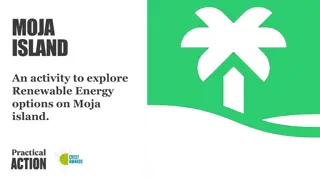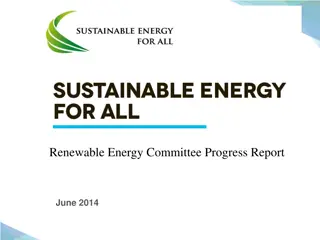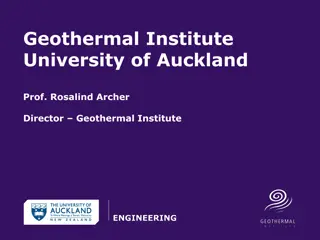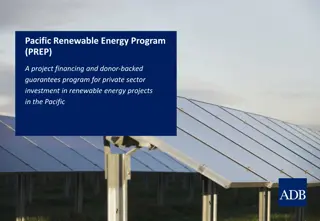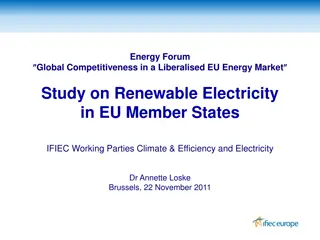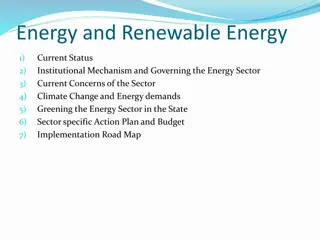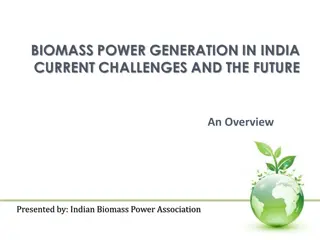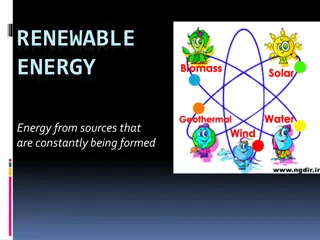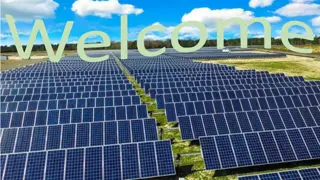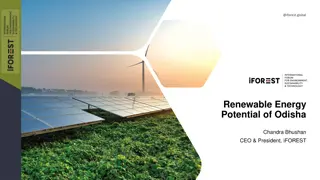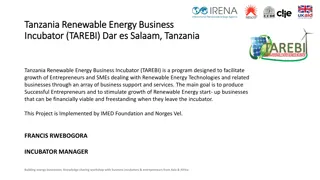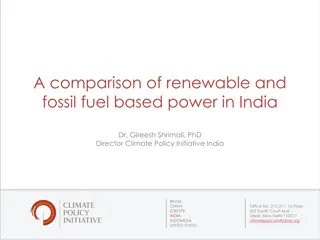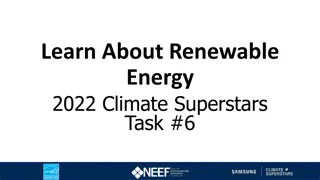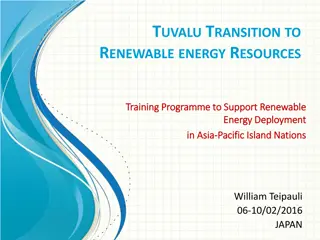Harnessing Wave Energy: A Renewable Resource for Sustainable Power Generation
Utilizing the kinetic energy of ocean waves through transverse and longitudinal wave interactions, wave energy presents a promising renewable resource for electricity generation. This form of renewable energy, akin to wind power, involves converting the motion of waves into electrical power by deploying turbines connected to generators. Through innovative technologies, wave energy has the potential to contribute to a greener and more sustainable energy mix.
Download Presentation

Please find below an Image/Link to download the presentation.
The content on the website is provided AS IS for your information and personal use only. It may not be sold, licensed, or shared on other websites without obtaining consent from the author. Download presentation by click this link. If you encounter any issues during the download, it is possible that the publisher has removed the file from their server.
E N D
Presentation Transcript
Energy From Waves Longitudinal and Transverse Waves as Renewable Resources
What is Renewable Energy? Energy that is generated from natural processes that are continuously replenished. This includes sunlight, geothermal heat, wind, tides, water, and various forms of biomass.
Wind Farm Rush Springs, Oklahoma How A Wind Turbine Works
Energy Transfer In Ocean Waves Is Similar To Wind Waves The kinetic energy of an ocean wave (transverse wave) turns a turbine attached to a generator, which produces electricity. The kinetic energy of a wind wave (transverse and longitudinal wave) turns a turbine attached to a generator, which produces electricity.
Using the Power of the Waves Using the Power of the Waves Wave Energy is type of ocean based renewable energy source that uses the power of the waves to generate electricity. This energy, not the water, moves along the ocean s surface.
Wave Energy Wave Energy Waves can travel (or propagate ) long distances across the open oceans with very little loss in energy. Wave energy converts the movement of the ocean waves into electricity by placing equipment on the surface of the oceans The equipment uses motion of the waves to convert the mechanical energy into electricity by using a generator.
Parts Of The Ocean Wave Amplitude of an ocean wave depends on the weather conditions, the amplitude of a smooth wave, or swell, will be small in calm weather but much larger in stormy weather. The wave period (T) is the distance between each successive crest, or trough. The period is the time in seconds between each crest of the wave. The reciprocal of this time ( 1/T ) gives us the fundamental frequency of the ocean wave.
Ocean Wave Power Devices Ocean Wave Power Devices Depending on the distance between the energy conversion device and the shoreline, wave energy systems can be classified as: Shoreline devices Nearshore devices Offshore devices
Four Basic Capture Methods From Ocean Waves 1. Point Absorbers Small vertical devices that absorb the waves energy from all directions. Convert the up-and-down pitching motion of the waves into rotary, or oscillatory, movements in a variety of devices to generate electricity. http://1.bp.blogspot.com/_b5hcKABPlGI/TMRkkwTXoWI/AAAAAAAAjKE/kU_1AmiAwNY/s400/10-2410a.jpg
Four Basic Capture Methods From Ocean Waves Continued 2. Wave Attenuators (also known as linear absorbers ) Long horizontal semi- submerged snake-like devices that are parallel to the direction of the waves. Wave motion of the device is used to move a hydraulic piston, called a ram, forcing high pressure oil through a hydraulic turbine generator producing electricity. Attenuator Wave
Four Basic Capture Methods From Ocean Waves Continued 3. Oscillating Water Column A partly submerged chamber fixed directly at the shoreline which converts wave energy into air pressure. Waves enter and exit the chamber pushing the air above the surface of the water back and forth. The air movement is channeled through a wind turbine generator to produce electricity.
Four Basic Capture Methods From Ocean Waves Continued 4. Overtopping Devices (also known as spill-over devices) Fixed or floating structures that use ramps and tapered sides positioned perpendicular to the waves. The sea waves are driven up the ramp and over the sides filling-up a small reservoir which is located above sea level. The water inside the reservoir is then returned back to the sea through a turbine generator to produce electricity.
Wave Energy Advantages Wave Energy Advantages Wave energy is an abundant and renewable energy resource as the waves are generated by the wind. Pollution free as wave energy generates little or no pollution to the environment compared to other green energies. Reduces dependency on fossil fuels as wave energy consumes no fossil fuels during operation. Wave energy is relatively consistent and predictable as waves can be accurately forecast several days in advance. Wave energy devices are modular and easily sited with additional wave energy devices added as needed. Dissipates the waves energy protecting the shoreline from coastal erosion. Presents no barriers or difficulty to migrating fish and aquatic animals.
Wave Energy Disadvantages Visual impact of wave energy conversion devices on the shoreline and offshore floating buoys or platforms. Wave energy conversion devices are location dependent requiring suitable sites were the waves are consistently strong. Intermittent power generation as the waves come in intervals and does not generate power during calm periods. Offshore wave energy devices can be a threat to navigation that cannot see or detect them by radar. High power distribution costs to send the generated power from offshore devices to the land using long underwater cables. They must be able to withstand forces of nature resulting in high capital, construction and maintenance costs.
Wave Energy Summary Wave Energy Summary The idea of harnessing the tremendous power of the oceans waves is not new. Like other forms of hydro power, wave energy does not require the burning of fossil fuels, which can pollute the air, contributing to acid rain and global warming. The energy is entirely clean and endlessly renewable. Wave power has many advantages compared to other forms of renewable energy with its main advantage being that it is predictable.
Resources http://okswnews.com/2016/12/05/rush-springs-public-schools-is-looking-to-pass-a-10-3-million-bond/ https://www.youtube.com/watch?v=DILJJwsFl3w https://extension.psu.edu/what-is-renewable-energy http://www.alternative-energy-tutorials.com/wave-energy/wave-energy-devices.html https://www.researchgate.net/figure/1-An-oscillating-water-column-wave-energy-converter-Source-George-2009-Used-with_fig2_267566259 http://coastalenergyandenvironment.web.unc.edu/ocean-energy-generating-technologies/wave-energy/the-pelamis-wave-energy-converter/ https://www.sciencebuddies.org/science-fair-projects/project-ideas/Energy_p037/energy-power/build-an-oscillating-water-column-to-extract- energy-from-ocean-waves#background https://www.pdxmonthly.com/articles/2009/5/19/0708-features-fathom https://blackfishengineering.com/2018/04/23/wave-energy-converter-technologies-9/






